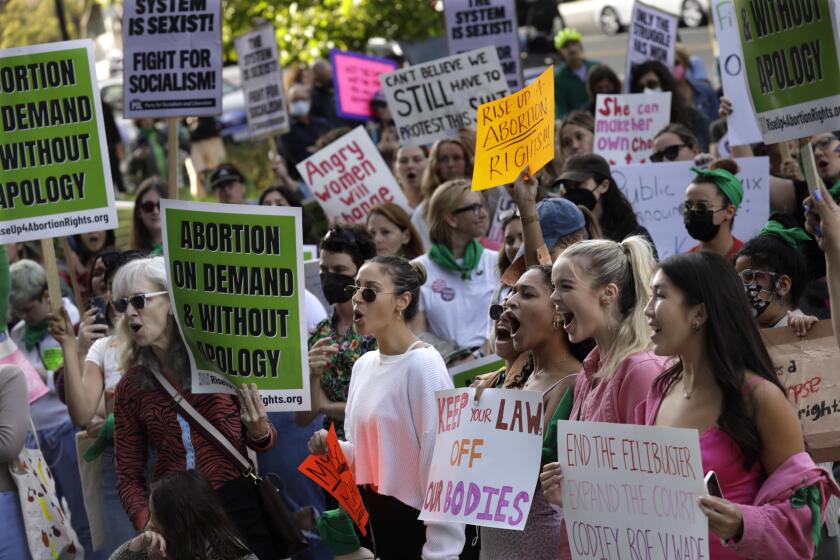In the ’90s, a new breed of rock stars organized for abortion rights. Could that happen today?
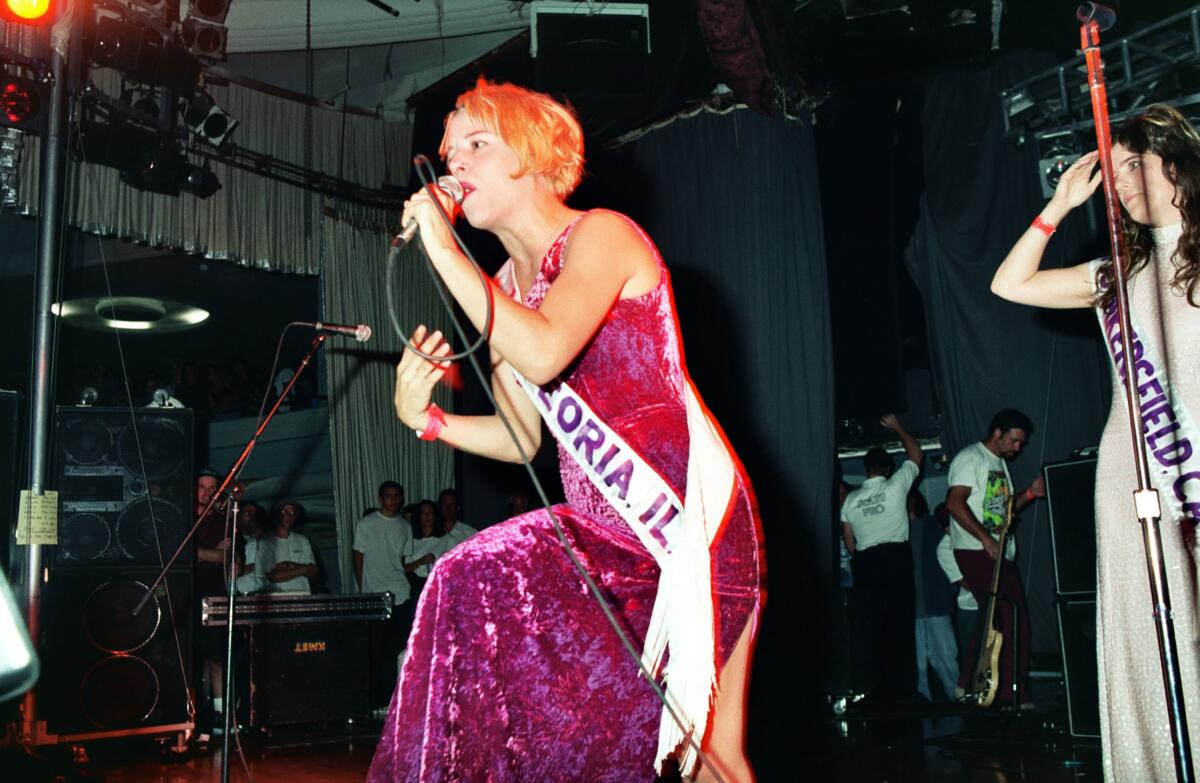
- Share via
This past June, across the Atlantic, over 200,000 fans descended upon the pastoral English village of Pilton, Somerset, for this year’s Glastonbury Festival. Yet for many in attendance, particularly for U.S. citizens, the weekend’s music was overshadowed by some breaking news: On June 24, the U.S. Supreme Court voted to reverse Roe vs. Wade, the crucial 1973 ruling that the right to an abortion was protected by the Constitution.
The move allowed lawmakers in over a dozen states to swiftly advance policies that would criminalize those who perform and seek out abortions.
For the record:
10:58 a.m. July 12, 2022A previous version of this story described L7 singer-guitarist Donita Sparks as an intern at L.A. Weekly; she began as an intern, then worked as a designer at the paper for more than eight years. It should also be noted that Sparks, together with artist Kirk Canning, designed the Rock for Choice logo.
Among the American artists who took the stage at Glasto, the backlash was swift. “Today is a really, really dark day for women in the U.S.,” lamented Billie Eilish to her fans. Indie-rock star Phoebe Bridgers stoked the crowd with chants of “F— the Supreme Court,” while Houston rapper Megan Thee Stallion asked audience members to repeat the fiery slogan, “My body, my motherf— choice.”
Teen hitmaker Olivia Rodrigo, joined onstage by English singer Lily Allen, unleashed her own furious missive to the justices who voted to overturn Roe, noting that many women and girls would die as a result of their decision. “At the end of the day, they truly don’t give a s— about freedom,” hissed Rodrigo, before kicking off a live refresher of Allen’s 2009 kiss-off to President George W. Bush, “F— You.”
Eilish, Rodrigo, Bridgers, Megan: Young, popular artists unafraid to speak their minds, with millions upon millions of followers on social media. And they were far from the only entertainers raising their voices: Scores of other musicians, from Kendrick Lamar to Halsey, took to Twitter and other outlets that weekend decrying the overturning of Roe.
But is tweeting, or creating a video that goes viral for a weekend, enough? Is it effective? What would happen if this new generation of American stars actually organized around reproductive freedom?
A possible answer can be found 30 years ago, when the all-women grunge band L7, in conjunction with L.A. Weekly journalist Sue Cummings and the Feminist Majority Foundation, founded Rock for Choice, a series of benefit concerts that raised money for abortion rights groups and clinics in the United States.
During a decade under conservative rule in the White House, many hard-won victories of the American feminist movement were being undermined or undone. In 1991, attorney Anita Hill testified on live television, alleging then-Supreme Court nominee Clarence Thomas of repeated acts of sexual harassment while working as his assistant at the Department of Education and the Equal Employment Opportunity Commission. (Thomas became one of five justices who voted to overturn Roe vs. Wade in June.)
Under President George H.W. Bush, the Supreme Court had given the states authority to restrict abortion using a number of measures, including parental consent laws, mandatory waiting periods and gag rules that forbade federal clinics from sharing information about abortion. An antiabortion group named Operation Rescue had established Los Angeles as its “decisive battleground” and began flanking reproductive health clinics all over the city with protesters.
“I thought, ‘Who the hell protests in Silver Lake?’” says Donita Sparks, singer and guitarist for L7. Sparks, 59, first took notice of the antiabortion actions during her daily commute to the L.A. Weekly office, when she worked as a designer in the art department. After late nights spent partying with her bandmates on the Sunset Strip, she would head straight to her local women’s clinic in the mornings to shield patients and their clinic escorts from screaming demonstrators.
Sparks recalled the experience during a 1990 interview with Cummings. That year, “Smell the Magic,” L7’s sophomore release on Sub Pop, earned a four-star review in Rolling Stone; a few months later, the band opened for Nirvana on their U.K. tour.

With L7’s feminist consciousness and heightened visibility, Cummings saw an opportunity to influence politics. In the early ’90s, protest was “in the air,” she says. Virgin Records had just launched its Rock the Vote campaign with MTV, and Red Hot, a nonprofit dedicated to fighting AIDS, raised money by issuing compilation albums and exclusive releases from George Michael and Madonna.
“Donita told me she once did a benefit show for Planned Parenthood called ‘Rock Against Coat Hangers,’ ” says Cummings with a laugh.
To that, she suggested: “‘Why don’t we try something bigger?’”
Cummings phoned several feminist organizations, asking them to co-sponsor a benefit concert with L7 that fall. The first organization to convene with the rockers was the Feminist Majority Foundation, a national nonprofit that played a pivotal role in securing the legal use of the French-manufactured abortion pill RU-486, or mifepristone, in the United States. In 1989, the organization established an initiative called the National Clinic Access Project, which garnered support amid escalating violence and legal restrictions on reproductive health clinics in the U.S.
“The women from the Feminist Majority didn’t really get our attitude — we brought them a logo of a girl smashing a guitar, ” says Cummings, referring to the now-famous silhouette of L7 drummer Dee Plakas, which was designed by Sparks and Plakas’ husband, artist Kirk Canning. “I think they were afraid of an image like that.”
DuVergne Gaines, director of the National Clinic Access Project, was more thrilled than scared; back then, she was an intern at the Feminist Majority, the foundation’s public advocacy wing, and eventually entrusted with co-organizing Rock for Choice in 1992.
“Dangerous things were happening at clinics: protests, blockades,” says Gaines. “Providers started getting killed. We needed a dedicated grassroots effort, and that dovetailed with the DIY ethos of Rock for Choice. But the foundation’s leadership just wasn’t sure about the rock scene.”
Here’s everything you need to know about the U.S. Supreme Court’s decision on Roe vs. Wade.
At this time, the initial reticence was understandable. Though gender-bendingly glam in its presentation, the macho specter of ’80s hair metal bands like Van Halen and Mötley Crüe still lorded over Los Angeles. In contrast, grunge — the unkempt, punk-rock, socially progressive answer to rock ’n’ roll decadence — was just beginning to bubble up in the Pacific Northwest, and would soon make headway in the Top 40.
“We were the children of women’s lib,” says Sparks. “L7 played benefits for Greenpeace, for ACT UP, for building schools in Nicaragua. Feminist Majority was fighting the good fight, but their idea of protest music was folk music. At the conference table, somebody said, ‘Maybe we can get Bonnie Raitt and Jackson Browne to play?’ I said, ‘Let’s give these people a break. We’ve got friends in this band called Nirvana. They’re gonna be really big, and we think we can get them.’ ”
The first Rock for Choice show took place in Los Angeles on Oct. 25, 1991, at what was then known as the Hollywood Palace on Vine Street. Headlining was the Seattle band Nirvana, who, after releasing its Gen X landmark “Nevermind” album in September, was hurtling toward superstardom.
“Keep your laws off my sister’s body,” riffed frontman Kurt Cobain, before the band ripped open their set with “Jesus Doesn’t Want Me for a Sunbeam.”
On this night, however, declared Richard Cromelin for the L.A. Times, “the gals out-rocked the guys.” The bill included feverish sets by L7 (Sparks, Plakas, Jennifer Finch and Suzi Gardner) and Courtney Love’s Hole; San Francisco’s Sister Double Happiness opened. Outside the venue, which had quickly reached capacity, young people were clamoring to gain entrance.
“We kept a table for voter registration in the lobby,” says Sparks. “Sofia Coppola showed up with Steve McDonald from Redd Kross — they were a couple at the time, and they wanted to get in. But everybody wanted to get in. So we were like, ‘Cool, can you do voter registration?’ And they did. People were waiting for the opportunity to do something, they just needed an anchor.”
“I don’t even remember much about the music itself,” says Cummings, “but I remember when [Nirvana bassist] Krist Novoselic got on stage and said, ‘If you don’t believe in abortion, don’t have one!’ It was exciting, it felt like there was this huge momentum behind us.”
Yet the scene unfolding backstage at the Palace, recalls Love, was much more sobering. She stood in a circle with members of Hole and L7, as well as several organizers, as they each shared personal stories about their abortions.
“It was what the great poet, activist [and] scholar Audre Lorde recommended — sitting and dialoguing together as women in a room,” Love told The Times in an email.
“We wrote down how many abortions we’d had, put them in a jar, then we read the numbers,” she says. “The highest number belonged to an upper-middle-class, college-educated professional. We discussed the circumstances, who was sad, who was glad. Were there any regrets? None. [We] all shared the same point of view on our right to a safe abortion.”
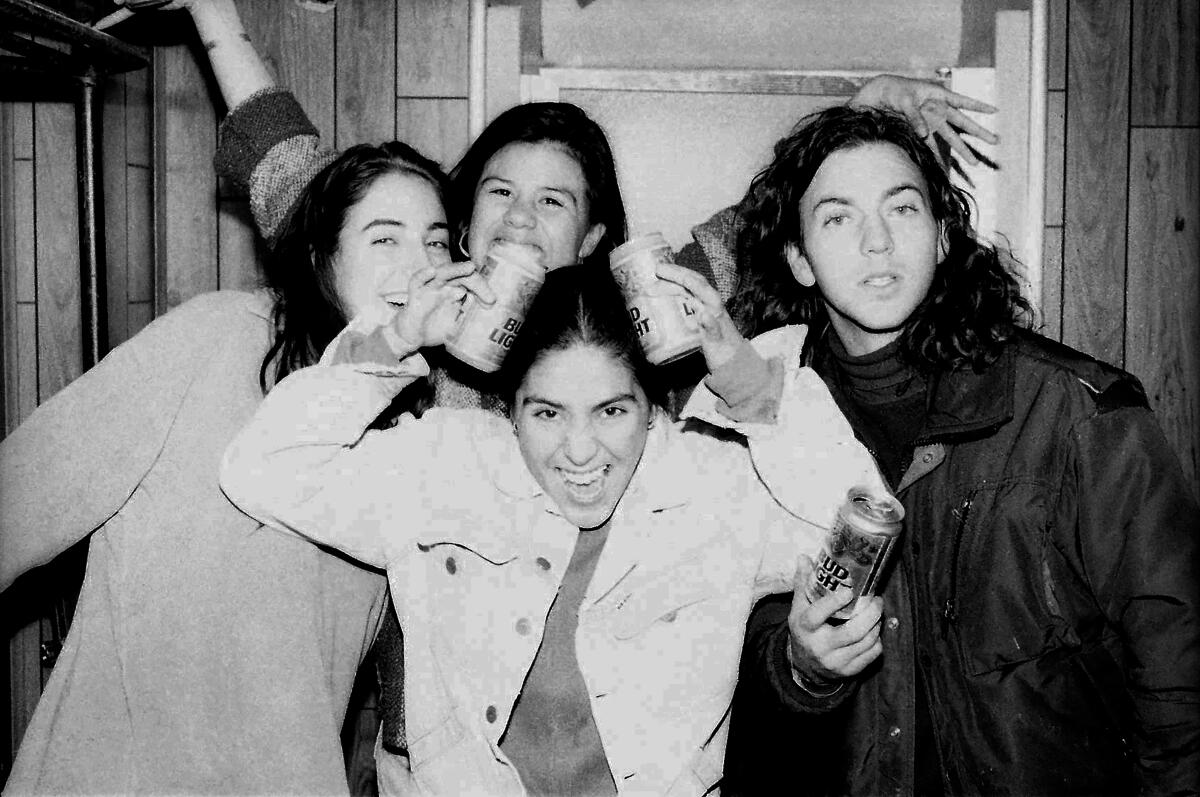
The Palace show would soon propel a national movement guided by rock bands. Feminist Majority enlisted the help of the late Rick Van Santen, an L.A. punk promoter and co-president of live event company Goldenvoice. By 1992, the Rock for Choice shows were headlined by platinum bands like Soul Asylum, Soundgarden and Pearl Jam.
Bikini Kill, contemporaries of Nirvana and originators of the feminist riot grrrl movement in punk, joined the Rock for Choice initiative in April 1992. They opened for L7 and the hardcore band Fugazi at a Rock for Choice concert in Washington, D.C. In the audience was legendary proto-punk guitarist Joan Jett; the show, says Bikini Kill drummer Tobi Vail, felt like an initiation of sorts.
“I was 22 at the time, and I was just scared,” says Vail. “We were in D.C., in the seat of power, with a government that didn’t seem to care whether we lived or died. It felt like people weren’t taking it seriously. But L7 took us under their wing. It was an honor to play [Rock for Choice] and be part of this community of women in punk.”
“I remember Bikini Kill played a really strange show at the Palladium,” recalls Vail of a 1993 gig in Los Angeles, where they shared the bill with Bad Religion, Free Kitten, King Missile, White Zombie and Stone Temple Pilots. In response to a surge of threats from men at previous shows — and perhaps bracing herself for a more masculine crowd — lead singer Kathleen Hanna famously appeared in a homemade red body-con dress with white iron-on letters that posed a dare to her detractors: “KILL ME.”
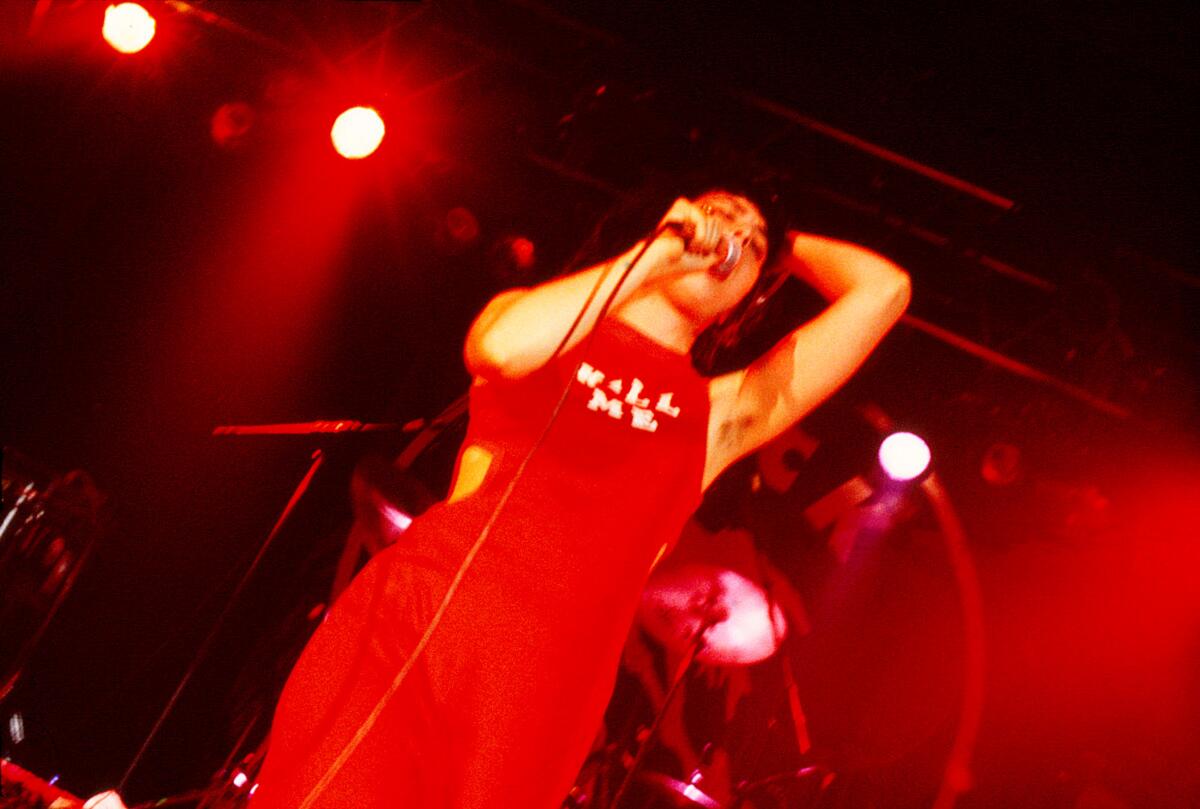
Rock for Choice-affiliated shows began cropping up in nonrock scenes as well; in San Francisco, a November 1992 show billed as “Rap for Choice” featured acts like YoYo, Chill EB and The Poetess; in May of 1993, Deee-lite co-founder DJ Dmitry headlined a “Rave for Choice” club night in New York.
“We had concerts all over the place, from really small shows to big arenas, like the Pensacola Civic Center,” says Gaines, referring to a 1993 concert in Florida, which starred L7, Pearl Jam and Follow for Now.
The choice in location was deliberate: Two doctors, as well as a clinic escort, had just been murdered in Pensacola. One of them was Dr. David Gunn, who was shot by an anti-abortion fanatic in March 1993. This came after the Supreme Court’s Bray decision, which in January 1993 ruled that abortion opponents had not violated any laws by obstructing access to clinics.
“People made violent threats in Pensacola,” says Gaines. “We paid for a lot of overtime for the entire sheriff’s department, because they wouldn’t let the concert go forward unless we had massive security. We had to get a SWAT team on the roof of the Civic Center.”
Gunn was was survived by his son, David Gunn Jr., who appeared with L7 at a later show in Los Angeles. The band, dressed as pageant queens, each bore a sash with the name of a city where abortion clinics were violently attacked: Peoria, Bakersfield, Newport Beach.
“It was important to encourage people to vote and be part of something bigger than us,” says Sparks. “Rock for Choice let people in our generation know that it was OK to give a s—. We raised hundreds of thousands of dollars for abortion. More women got elected to office in 1992 than ever before. That year, Bill Clinton got elected president, and then signed legislation in our favor,” she adds, such as the 1994 Freedom of Access to Clinics Act.
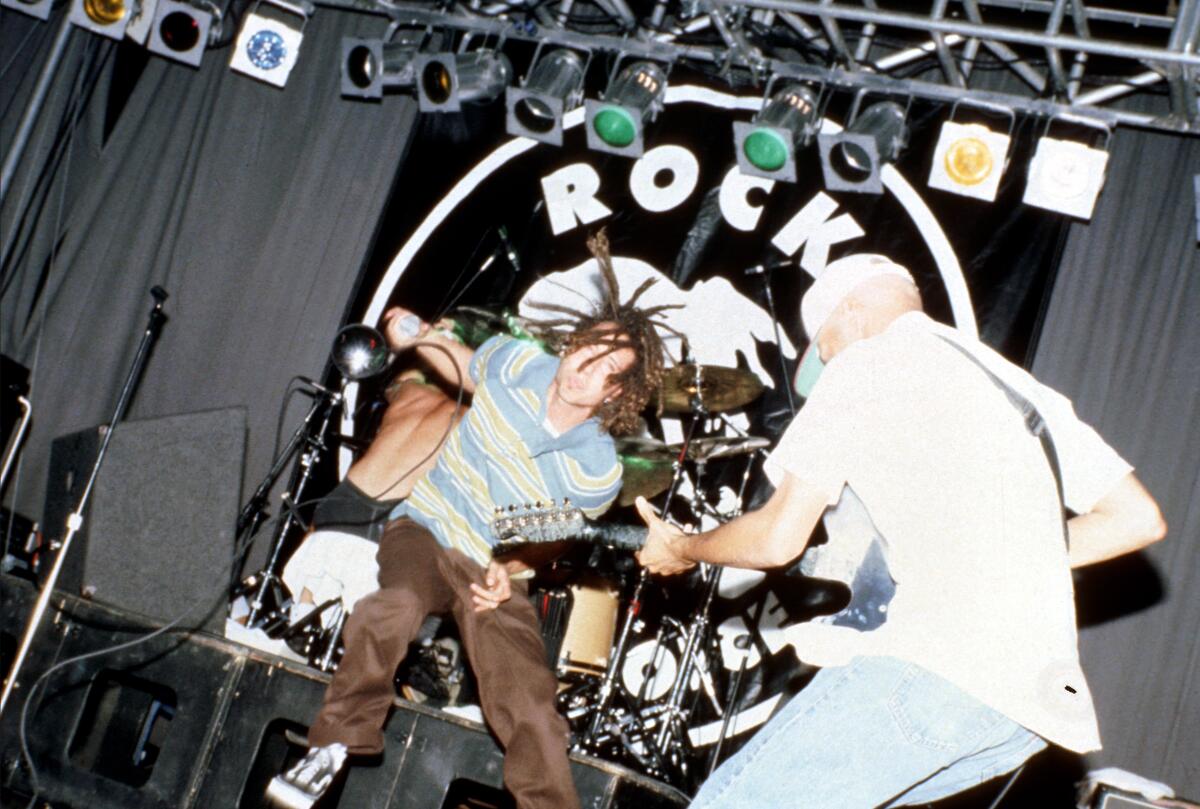
More MTV mainstays would grace the bills of Rock for Choice shows, including Rage Against the Machine, No Doubt, Beastie Boys and Korn. The final Rock for Choice concert took place in January 2004, after a 2003 late-term abortion ban was signed into law by George W. Bush. True to the folky persuasions of the Feminist Majority’s upper ranks, it was an acoustic showcase, starring Lisa Loeb, Ben Harper, Melissa Etheridge and Sheryl Crow.
Rock for Choice was discontinued after its main promoter, Van Santen, died that year. “Putting on a rock show isn’t easy, and Goldenvoice stood by us through thick and thin,” says Gaines. But she remains hopeful that Rock for Choice — or something similar — could make a comeback.
“We need to show up for independent clinics right now,” she says. “Extremists have continued to wage a war of violence and intimidation against reproductive healthcare providers. And the Supreme Court has announced, in its own way, an open season on providers again.”
“The good news is that the majority of people believe abortion should be legal, accessible and affordable,” says Vail, citing a recent survey that determined a 61% majority of U.S. adults support legalized abortion. “The bad news is, a conservative minority has taken over the government. How do we get the will of the people into power?”
President Biden signed an executive order on Friday that includes protections of access to abortion medications such as mifepristone and misoprostol, as well as contraceptives like hormonal birth control and intrauterine devices.
However, the executive order would only apply in states where abortion has not been banned or severely restricted.
Amid the onslaught of antiabortion legislation, a number of pop stars, including Katy Perry, Ariana Grande and Lizzo have pledged generous donations to Planned Parenthood. One prominent collective of American artists and entertainers, organized under the banner “Noise for Now,” has raised over $675,000 for reproductive justice organizations since its first benefit concert at the Santa Fe Opera in 2017. Members include Rock for Choice veterans like Bikini Kill, but also count newcomers like Mitski, Soccer Mommy and Angel Olsen among their ranks.
Amelia Bauer, executive director of Noise for Now, was not familiar with Rock for Choice when she began organizing shows. When the pandemic brought their live benefit model to a standstill, the group turned to online, merchandise-based initiatives. “One of the positive aspects of turning to social media when [live music] shut down is that we were able to greatly expand the network of musicians, actors and athletes that we work with,” says Bauer.
“Now that folks are back on tour, we are able to take things one step further,” she adds, namely by distributing abortion information cards at merch tables and partnering with the organization Plus1. “They add a dollar per ticket to every show on a given tour for distribution to independent abortion clinics and abortion funds.”
Vail, who will tour the U.S. with Bikini Kill this summer, believes in the power of today’s activist youth to continue where Rock for Choice left off; only this time, she says, they’ll have a much bigger and more inclusive feminist movement than her cohort did in the ’90s.
“If we’re talking bodily autonomy, and we’re talking about abortion, we also need to talk about race,” she says, citing the work of the Atlanta reproductive justice group, SisterSong. “We need to talk about the economic viability of raising children in safe and sustainable environments. We need to talk about trans rights. Intersectionality is not divisive. This is how we get more people involved.
“We’re gonna need a mass movement,” says Vail. “Let that be the unifying point.”
More to Read
The biggest entertainment stories
Get our big stories about Hollywood, film, television, music, arts, culture and more right in your inbox as soon as they publish.
You may occasionally receive promotional content from the Los Angeles Times.
